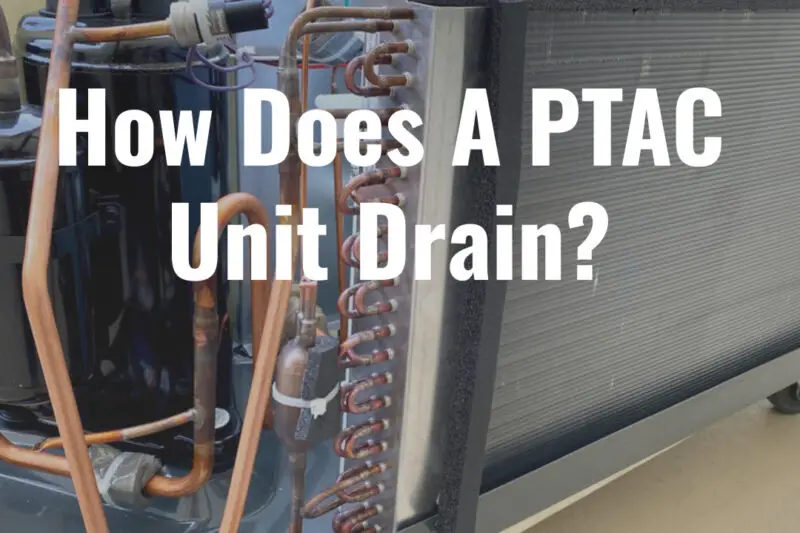Building wall systems would be excellent if we didn’t poke holes in them. Bluco Mechanical is full of HVAC experts and we are eager to help with any questions on How Does A PTAC Unit Drain?
The Packaged Terminal Air Conditioner (PTAC), which is ubiquitous in hotels and multifamily buildings, causes many of these holes. Through-the-wall units that permanently cool or heat specific rooms. PTAC design and construction methods vary, however they commonly allow water into the structure.
Basic wall waterproofing ideas can be used to make PTAC installations that are both reliable and long-lasting, no matter where the water comes from.
PTAC Water Management
The PTAC chassis’ condensate pan can either be topped up or have a valve in the sill that opens when the temperature drops below a certain level. Water comes right into the sleeve from the louver.
When there are weep slots on the front edge of the sleeve, water is supposed to go through the louver or the louver framing, depending on how the louvers are installed. This is how the water should go.
Bad Manufacturer Directives
Installation of the wall sleeve and other PTAC components is often guided by textual and schematic instructions. In many situations, these instructions fail to show basic exterior wall waterproofing components, making it difficult to properly integrate the wall sleeve with the outer wall waterproofing. To ensure the system is effective, the designer should provide adequate detail and trade coordination.

Typical Components In PTACs
- Wall sleeve, usually sheet metal or molded plastic, installed in the wall aperture.
- Air intake and exhaust via a wall sleeve Louver.
- Evaporator coil, blower (interior fan), compressor, condenser coil, condenser fan, controls and other equipment. The Chassis contains a condensate pan to collect and drain water from the evaporator coil. Slinger rings are used in several PTAC service New Jersey designs to help evaporate condensate from the pan and boost efficiency.
- End-user controls are housed in a room cabinet mounted inside the PTAC.
On a typical brick veneer wall, from exterior to interior, are: brick veneer, drainage cavity, sheathing, frame and internal wallboard. A steel lintel holds the brick veneer above the PTAC sleeve penetration.
Water resistant barrier on exterior sheathing, steel lintel above PTAC, and PTAC flashing are all missing from the sketch. The manufacturer recommends sealing the PTAC sleeve penetration on the exterior and interior. It should protrude one-quarter to five-eighths inch from the wall’s outboard face. The watertight wall sleeve collects wind-driven rain that penetrates the outer louver and condensate that flows from the condensate pan.
Others specify that the wall sleeve be fitted level. Manufacturers recommend flashing beneath the PTAC sleeve only when a sleeve extension is necessary for deep wall portions. End dams but no raised leg on the inside and no slope on the outside are common flashing details.
Wrong Design Drawings
Many construction drawings fail to integrate the wall sleeve with outer wall waterproofing. Assemble critical parts to avoid failures.
The interior and end dams of a flashing visible behind the PTAC sleeve are commonly missing panned-up legs to collect water.
It is difficult to install a water-resistant system without detailed drawings, such as blown-up section views or isometric views of flashing terminations and other intricate transitions.
3 Common Water Leakage Problems
Unflashed perimeter joints between the louver or sleeve and the adjacent wall cladding (plastic sleeves are molded and do not have vulnerable corners).
Remember these leak sources and how to stop them:
-
Leakage at the Louver/PTAC Sleeve Interface
Louvers direct rain away from the assembly but do not stop wind-driven rain or rain brought in by the PTAC fan. Water bypassing the louver flows against the louver-sleeve joint, and some flows into the sleeve.
The inboard face of the louver and the sleeve are intrinsically leaky. A quarter inch outside the wall system allows leaks to fall harmlessly beyond the wall face. However, this solution ignores the requirement that louvers be flush with or slightly recessed from surrounding wall surfaces.
The Louver’s susceptible joint is inside the wall when flush or recessed. The surfaces that mate are uneven and typically include sleeve fasteners that impede or puncture these seals, rendering them useless.
Waterproofing at Wall Penetrations
Water leakage at wall system penetrations is one of the most common building performance issues faced by designers, builders, and building owners. Waterproofing techniques that can eliminate leaks include:
- Use long-lasting water-resistive sheet membranes such as unperforated asphalt felt and self-adhering rubberized asphalt membranes. The membrane should last as long as the wall cladding.
- Allow water to drain down the wall outside the WRB.
- Provide flashings for all WRB horizontal breaks.
- Whenever feasible, combine water and air barriers onto one sheet.
- Enclose the wall membrane(s) completely.
- Slopes that drain quickly.
- Avoid wall systems that omit the sheet membrane in favor of taping the sheathing board seams. In addition, the tape’s upper edges can lose adherence with time, allowing leaking.
- Extend flashings slightly beyond the wall’s face and drip down the edge to prevent water from flowing around the edge and back in.
In many cases, condensate drains immediately through the seal between the louver and the sleeve. Some installations feature birdscreens inboard of the louver, sandwiched between the louver and the PTAC sleeve, allowing leakage.
Leakage through the louver-to-sleeve junction occurs due to both rain penetration and humidity. In this case, a full pan flashing is necessary unless the joint is outboard of the outer wall face.
2) PTAC Sleeve Perimeter Leakage
They lack perimeter flashing around the wall opening. Water does not enter the wall cladding because of continuous sealant adhesion between the wall cladding and the wall sleeve.
Incorrect sealant application, incompatible materials, substrate joints, sealant degradation due to exposure to the weather, and other causes result in gaps or loss of bond in the sealant. This approach often leaks profusely.
In the absence of head flashing, the sleeve redirects water flowing down the wall assembly above the unit to the interior.
3) Sleeve Leakage
Water drains from the sleeve’s wall either internally or through weep slots. Sleeves are placed level if internally drained. Because the sleeves don’t pitch to the internal drains, some water remains. The stagnant water encourages organic growth.
Ponded water occurs when the sleeve deflects due to inadequate sleeve and chassis support. Sleeve distortion is a major issue with plastic sleeves that creep.
The waterproof integrity of the sleeve sill corners is crucial to preventing leakage to an interior floor with either kind of sleeve drainage.
Plastic sleeves have impermeable molded corners unless damaged. Metal wall sleeves commonly have a cut and lapped internal return flange. The lap joint is sealed to keep water out of the sleeve. When exposed to prolonged ponding, the sealant-to-metal bond begins to weaken.
Due to improper pitch and reliance on sealants, wall sleeve corners leak, causing deterioration of interior finishes close to and below the sleeve corners.
Principles Of Waterproofing
Unfortunately, most manufacturers’ standard specifications and architectural designs lack fundamentally sound, time-proven waterproofing solutions. If used in curtain, cavity, or barrier walls, PTAC wall sleeves must have perimeter flashings for durability.
To avoid PTAC leakage, use the following design recommendations.
TIME FLASHINGS
PTAC designs, like other outside wall penetration designs, must account for the reliability and durability of perimeter sealant joints. The design should include flashings to collect and drain water that bypasses the perimeter seals.
Sill: An inverted leg inboard of the wall sleeve, end dams on either side of the wall sleeve, and a down-turned drip edge that extends beyond the outside face of the exterior wall should all be present. The metal flashing should extend beyond the PTAC opening.
Head: The brick is supported by a loose steel lintel since the PTAC sleeve cannot properly support it above the sleeve penetration. A metal drip edge flashing extends beyond the louver’s top and engages a continuous metal hook strip embedded in sealant on the wall sleeve. On the outer wall sheathing, metal flashing covers the horizontal lintel leg and extends up to the vertical lintel leg. The water barrier overhangs the metal flashing. The metal flashing should have end dams that extend past the PTAC aperture.
Jamb: The water barrier should extend the full depth of the wall opening and lap over the sill flashing below.
Curtain & Window Wall Flashings
The flashing for PTACs in curtain walls or window walls is identical to that for hollow wall systems. The flashings must either drain directly to the wall or into a glazing pocket open to the external. In flashing installations, the sill pan should extend beyond the outer face of the wall to drain water outboard of the glazing pocket.
Drain Slope
One of the most basic principles of excellent waterproofing is enough slope to encourage rapid drainage from waterproofing surfaces and prevent ponding water. PTAC wall sleeves require a quarter-inch per foot slope. Leveling shims may be necessary to meet the manufacturer’s specifications. A proper slope to drain reduces ponding water and eventual leakage at inboard wall sleeve corners.
Build and Install Properly
PTACs are a typical source of outside wall water intrusion. Manufacturers’ installation instructions and most design designs overlook basic wall waterproofing concepts. PTACs installed in line with these instructions and designs are prone to leakage.
However, careful design and construction can reduce PTAC leakage.
- Know that perimeter sealant joints are inherently unreliable and unstable. Provide perimeter flashings at the PTAC sill, head, and jambs that interact with the secondary waterproofing and drainage system (cavity walls) (glazing pockets of curtain walls or window walls).
- Install PTAC wall sleeves that slope to the exterior to drain water quickly. Shim the PTAC chassis per the manufacturer’s specifications.
Ensure your PTACs are built to survive a PTAC attack.
Call (929) 447-2077 for any questions regarding Bluco Mechanical NYC HVAC. Also find out Do PTAC Units Bring In Fresh Air? on our site now!



One Response to “How Does A PTAC Unit Drain?”